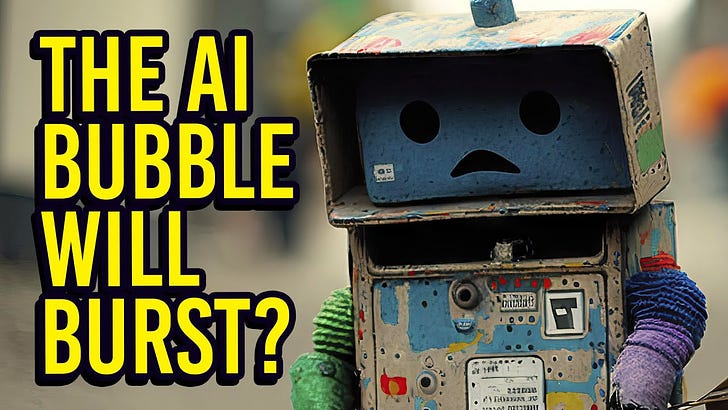Is the Generative AI Bubble Bursting? Good.
Now enterprises and organizations can focus on pragmatic implementations that work.
Monday’s stock market rout and a slew of negative reports fueled a new swell of AI influencer and business media stories speculating that the generative AI bubble is bursting. Whether or not a financial bubble has burst (or if there even is one) can be debated, but there is certainly an overzealous hype wave. If recent news portends the end of the hype wave, perhaps that’s great news for enterprises and organizations interested in implementing AI.
Candid observations about the generative AI hype have criticized Silicon Valley startups and big tech players alike for overpromising functionality and impact. Both Greg and I have cited companies like Open AI for a continuing series of product marketing failures, resulting in developing tech for tech’s sake instead of applications that businesses or consumers need.
A correction may force AI vendors to buckle down and redirect their focus toward developing products for specific customer uses. That’s true for applications targeting companies and organizations, or consumers alike.
Let’s look at the primary reasons behind the “generative AI bubble is bursting” discussion, and some of the implications of hitting “bottom.” Finally, we conclude with recommendations for enterprises and organizations.
AI Is Expensive
Building and maintaining large language model algorithms is expensive.
AI investments are through the roof with massive stock buying rallies for companies like Nvidia, which after the epic market sell-off on Monday was still valued at 2x its January 1 stock price. The stock market is not alone. Venture capitalists have gone gaga for generative AI companies, representing a plurality of the almost 40 unicorns achieving $1 billion valuations in 2024.
The enthusiasm for AI is well-founded but it may be misplaced in excitement about the generative suite of tools. Large language models like GPT and Llama require immense computing power (thus Nvidia’s boom) and are extraordinarily costly to maintain. Further, LLM development may be peaking with promised next-generation algorithms falling short of innovation expectations.
Perhaps more importantly, most enterprises — the large-scale implementation drivers of AI — greatly benefit from other forms of AI. Those algorithmic tools include but are not limited to machine learning, analytics, computer vision, natural language processing, image generation, automation (if you are liberal in defining AI), recommendation engines, and more.
AI is not a bust, but maybe the generative AI subset of tools based on LLMs are, at least as they are marketed to the public. Instead of a financial bubble burst, perhaps this moment represents a recalibration of expectations, and resulting investments into small-cap companies and other startups that present a better short-term ROI.
While big generative AI plays like Nvidia have suffered in recent days, it may be because they are simply overvalued. Public investors are hungry for technologies for a quicker path to revenue. They need look no further than the cloud companies hosting AI technologies, which have recorded almost $80B in revenue this quarter.
When the Market Leader Overpromises and Underdelivers with Technology
Perhaps most concerning for the generative AI hype cycle is the leveling off of LLM technologies. With the bar set by market leader OpenAI and its vaunted GPT algorithms, several competitors — Anthropic, Google, Meta, and Mistral — have all launched competing large language models close to or equal in capability.
Meanwhile, OpenAI’s race to wow the world with GPT 5.0 and its so-called artificial general intelligence (AGI) capabilities — has stumbled over and over again over the past year. Just this past Monday, OpenAI sought to deflate expectations with a less bombastic development day this autumn, featuring its current leading GPT models 4o and 4o mini instead of the much anticipated GPT 5 model.
As LLM technologies are only advancing incrementally and flaws like hallucination and ethical quandaries remain, the costs are becoming prohibitive. Is the itch worth the scratch? Is a more focused approach needed with smaller LLMs focused on specific industries? Is the current transformer approach failing, and is a new text generation approach needed to surpass this generation of LLMs?
All these are hard questions the larger technology sector is debating. CTOs and CIOs and their technology organizations are investing cautiously and with good reason. Directional shifts and time are needed for technology providers to meet enterprise needs.
Much has been said about the market leader OpenAI across the Internet, including this masthead. Perhaps no company epitomizes the hype cycle’s flaws than OpenAI. From overpromised results and flawed launches to ethical missteps and executive departures, OpenAI underwhelmed customers for the past two years. Monday’s development day news coupled with three senior executive departures offered more of the same.
To be fair, generative AI is much more than just LLMs and Open AI. Many companies are addressing other forms of media generation, including image and video. A host of competitors beyond OpenAI are addressing those diverse media as well as text generation. Generative AI is here to stay, regardless of this stage’s end game. Perhaps, it’s just time for a more business-minded leader.
Takeaways for Business Leaders
Shiny object syndrome still exists.
Those of us on the front line might be relieved to see the hype wave come to an end and with it, a tighter investment environment. Reduced speculation and more disciplined investment will bring a more refined approach to deploying AI solutions.
Enterprise and organization leaders demanding better results, more ethical sourcing, and secure handling of intellectual property should stick to their guns. Vendors who cannot meet these very reasonable needs — either through platform or custom solutions — are not ready to serve the enterprise market.
Further, questioning the veracity of vendor statements is essential. Promise and outcomes are two different things. Over and over again the demand for proof of concept must be met. That means implementations begin with pilot tests and more reasonable, narrower scopes. This more pragmatic approach helps: 1) Introduce AI to the enterprise in a less dramatic fashion; and 2) Allow leaders to understand AI’s potential value for their company or organization’s unique needs.
Finally, it pays to scope an enterprise’s actual business challenges and resulting technology needs. Over and over again the AI discussion returns to use cases. Too many times companies and organizations look at AI and ask how they can incorporate it. If a technology does not serve a use case and/or resolve a specific business need, it simply does not belong regardless of hype.
In the social media days, adopting tech for tech’s sake was called Shiny Object Syndrome. The principal remains. Just because a new technology is hot, does not mean it is right for your organization.
What do you think about the generative AI bubble bursting and the hype wave coming ending?
All images created on Midjourney.







Bravo, @Geoff. You and Greg always provide balanced and well-informed insight and analysis to his topic, regardless of how the media wants to portray it. It's just one more reason I keep CognitivePath on my must-read list.
I personally think we are in a bubble simply for the fact that current AI systems literally take no account for the experience of the human operator, always just focusing on new features, faster generation, things like that. At some point, we as humans just grow weary of its use, and then we experience fatigue with the technology, and following we simply start to ignore it. We have seen this time and time again.
People are starting to experience AI Fatigue as a legitimate phenomenon. As someone who is starting to experience it myself (I don’t want AI in my washing machine thank you very much) I have found a few case studies into researching my own conditions into it.
AI Fatigue: A Study into the Impact of Artificial Intelligence on Employee Fatigue
https://www.amazon.com//dp/B0D2BQV1DC
there are a couple others too, but just my two cents.